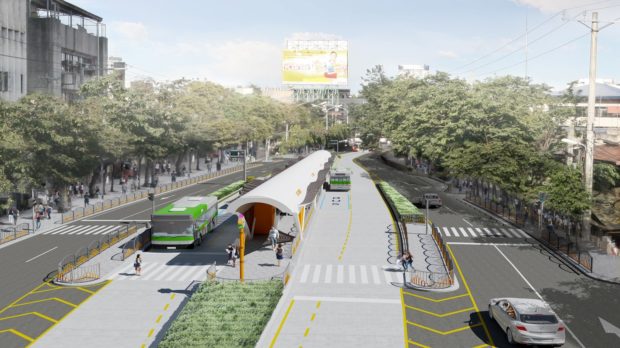
BUS STATION. This is the architectural design of one of the stations of the Cebu City Bus Rapid Transit project. —FACEBOOK
CEBU CITY, Philippines — The Cebu Bus Rapid Transit (CBRT) project could require a total of 9.3 hectares of land to be completed.
According to the final report on the resettlement plan for the CBRT published by the Department of Transportation (DOTr), formerly the Department of Transportation and Communications, in 2013, land acquisition from both private and public will be required by at least four components of the original CBRT alignment.
These are the CBRT terminal for Bulacao, 12 median stations, the depot, and the bus stops.
The consultant team produced the resettlement plan (RP) in parallel with the CBRT feasibility study (FS). The FS produced a preliminary design for the stations and terminal, which provided the basis for an initial estimation of the land requirements of the CBRT.
According to the 2013 RP, the land required for the CRBT is currently of different uses: purely residential; mixed residential and commercial; purely commercial; industrial; and institutional, while approximately 70 percent or 6.63 hectares of the land is private.
Using zonal valuation of the BIR, which was formerly SIR or Internal Revenue Service, in that year, it is estimated that the cost to acquire this land will be P620.5 million.
There is no final data yet as to how many families will be affected, but the report said a total of 243 structures as of 2013 were found to be standing on this land.
“Most of these structures are one-story tall. These structures have an estimated floor area of 2 hectares. The cost of reconstructing these structures is estimated to cost P499.97 million. In addition to these, the Cebu BRT will impact fences and parking lots,” reads a portion of the report.
Meanwhile, Engineer Bu Varquez, the Cebu City’s BRT project overseer, in an interview on Saturday, March 4, said that the CBRT land requirement could be lesser than 9 hectares with the revised BRT alignment in 2017.
Although, he noted that there was a chance that it could still be around 9 has. if the DOTr would reconsider revisiting and implementing the original BRT route plan.
To recall, Mayor Michael Rama last year has brought to DOTr his wish of revisiting the original route of the CBRT.
“Naa man nay revisions sa 2017…instead of going from N. Bacalso sa may flyover, mudiretso unta na siya sa Bulacao. [But] they found it a little expensive. Ang kana man gung cost pagkausab na sa basis sa DPWH, ang market value naman jud sa property [ang basis]. Maong nisaka from P10 billion to P16 billion na ang bag-o (budget),” he said.
(It has revisions in 2017…instead of going from N. Bacalso near the flyover, it would have directly go to Bulacao. [But] they found it a little expensive. The cost when the basis for the DPWH was changed, the market value of the property [the basis]. That is why the budget increased from P10 billion to 16 billion, which is the new one (budget).)
“Kung ipadayon pa jud to ang sa [original] Bulacao na alignment, mas mudako pa jud na (ang budget), mosobra pa siguro og P20 billion. But si mayor, ang iyang stand is ibalik g’yod to siya kay original man to. Daghan naman gud ni’g version ang BRT… ang kanang SRP wala man na originally maapil,” he said.
(If we continued with the [original] Bulacao alignment, it will be more costly (the budget), it will increase probably to P20 billion. But the mayor, his stand is to bring back the original one. The BRT has already many versions…the SRP was not originally included.)
The CBRT project is supposed to have a 21.58-kilometer corridor route with 16 kilometers of segregated bus lanes from Bulacao to Ayala Center Mall along Natalio Bacalso Avenue, Osmeña Boulevard, and N. Escario Street.
A six-kilometer stretch of bus priority lanes through curbside stations at junctions will allow BRT buses to reach Barangay Talamban along Gov. M. Cuenco Avenue.
After some changes in the project’s technical design, the project now covers a 35-kilometer road corridor; of this, 13.2 kilometers are dedicated busways from the South Road Properties (SRP) in the southeast to the north with 22.1 kilometers of three segments considered as feeder services.
The feeder segments are 8.7 kilometers from Mambaling in Cebu City to Talisay City, 8.2 kilometers from the SRP in Cebu City to Talisay City, and 5.2 kilometers from IT Park to Barangay Talamban.
During the ceremonial groundbreaking of the CBRT-Package One, President Ferdinand “Bongbong” Marcos, Jr. told the BRT proponent, DOTr to ensure that owners of properties affected by the CBRT would receive just compensation.
DOTr Secretary Jaime Bautista said they were still working on the total number of affected families, as most of the structures that would be affected would be during the start of Phase 2 and Phase 3 of the CBRT’s revised route.
READ MORE:
President Marcos to DOTr chief: Ensure just compensation will be given to affected lot owners
Cebu Bus Rapid Transit package 2 up for grabs
Capitol wants ‘just compensation’ from DOTr over Cebu BRT
Neda Board OKs 7 ‘high-impact’ projects
/dbs

